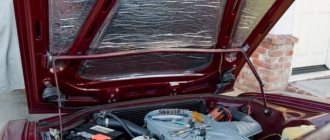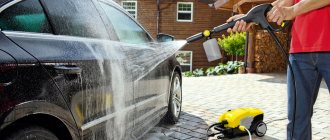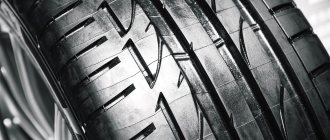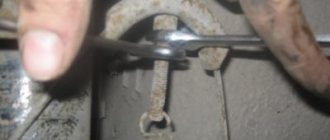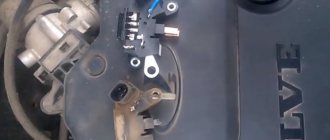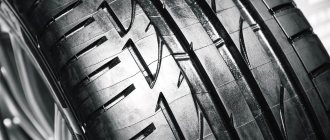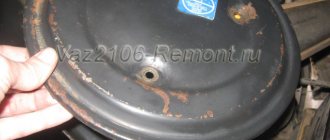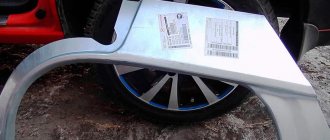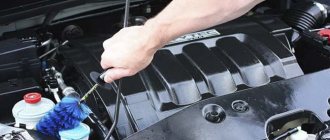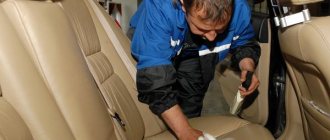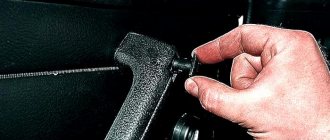When driving away from paved roads, almost anything can happen. For example, you may unexpectedly drive off the road into fields below. Or just in the fall or spring, when incessant rains have turned the country roads into an impassable swamp where even a powerful SUV, not to mention a standard front-wheel drive car, can get stuck.
In this article you will learn how to get out if you are stuck in the mud. As a rule, in such a situation you cannot do without the help of others, however, there are several ways in which you can get out of the mud on your own.
The first method: correctly distribute the weight on a car with rear- and front-wheel drive
It is much easier to get out of the mud with front-wheel drive, as it gives its owner greater maneuverability, which cannot be said about rear-wheel drive.
On front wheel drive:
- Unload the rear of the car and load the front. If you're traveling alone, simply move your luggage from the trunk to the front seat. If you are with a group, then leave one passenger in the front and get everyone out of the rear seats;
- Drive away smoothly and slowly turn the steering wheel left and right to try to find traction at the edge of the track.
On rear wheel drive:
- In this case, on the contrary, you need to load the rear axle and unload the front. Or simply move the passenger from the front seat to the rear.
- Just keep the steering wheel straight.
- Move slowly in the opposite direction. In this case, you can apply the handbrake to avoid wheel slipping.
Didn't help, is the car firmly seated? Then place tree branches, stones, boards, and rubber mats under the drive wheels. And again, we slowly try to get out of the mud.
Install anti-slip chains
Another effective way to increase grip. If you don’t have real chains in the trunk, try making homemade ones from scrap materials. Take a rope or tow rope and wrap it around the drive wheels like chains. The main thing is to secure them well so that they do not unravel and damage the brakes and suspension parts.
Even on summer tires with such improvised chains, you are almost guaranteed to drive out of any snow. By increasing traction on the surface, cross-country ability will be significantly improved. But you should be careful with the gas pedal, because with such wheels the risk of digging deeper increases.
The second method: “rocking up” on automatic and manual
If the previous method of getting out of the mud did not help you, try rocking your car. This can be done alone or with the help of friends. For this to work, the car needs to move forward and backward, gradually increasing the distance traveled. On a manual transmission, this is achieved by periodically engaging first and reverse gears. At the same time, try to spin your wheels as little as possible so as not to get stuck in the mud even more. And as soon as you feel that the car has swung to the maximum, try to drive sharply in the right direction. Also operate the clutch carefully so as not to burn it.
If you can't change gears quickly, you can try rocking the car using the clutch. As a rule, this works in cases where the car's wheels get into a recess. To do this, engage first or reverse gear and drive away slowly. And after you feel the wheels start to spin, release the gas and press the clutch. At this moment the car should roll in the opposite direction. And as soon as it stops rolling away and begins to return on its own in the right direction, release the clutch again, helping the car climb up. Most likely, you will have to repeat the above steps several times before you get out onto a solid surface.
How to get out of the mud automatically with the help of rocking?
As a rule, cars with automatic transmission are equipped with various additional electronics that prevent the wheels from slipping when cornering. That's why when you try to drive out of the mud, the car will behave completely differently. Moreover, with an automatic you will not be able to change gears at the same speed as with a manual. Therefore, no matter how hard you try, you won’t be able to rock the car by quickly changing gears. Even if you try to do this, your automatic transmission will simply refuse.
What to advise if a car with an automatic transmission is stuck in the mud? Everything is the same as in the previous case. Use the method of rocking the car halfway - without using reverse gear. That is, start moving all the way, and then simply roll in the opposite direction and forward again. Only instead of pressing the clutch, you need to switch the automatic transmission lever to the “N” position, and when you need to get under way, to the “D” position.
Why it is not recommended to skid
Slipping is an action that affects not only new car enthusiasts, but also experienced car owners. Everyone is familiar with the situation when you are in a hurry, flying at full speed to a meeting or home in the evening, you do not notice a snowdrift and drive into it.
Read
All about automatic transmission AF17 (AW60-41SN): algorithm, connection diagram, location
This makes you angry and you start rocking the car, just like you do with a manual car. Does everyone know this feeling? So, under no circumstances should you do automatic swinging.
Slipping is fraught with overloads on the planetary gearbox and torque converter of the machine. The following happens when you try to check out:
- The oil in the bagel overheats over 100 degrees in the machine. It cannot act as a protector and lubricant when overheated.
- Due to the constant shifting of gears from “D” to “R”, clutches and steel discs with teeth rub against each other intensely.
- Overheating affects all automatic transmission systems.
- As a result, the car owner receives an overheated automatic machine with a shortened lifespan.
Attention! After prolonged slipping, it is necessary to immediately change the lubricant in order to somehow smooth out the car owner’s mistakes.
Third method: use a winch or make one from scrap materials
You can also get out of the mud using a winch. It is selected according to the weight of your car. You can hook it to a tree, pole or other object. If you don’t have one, then you can make a winch from improvised materials.
To do this, you need to have a crowbar and two cables with you. You will also need a wooden block or a metal rod for leverage, but you can use a shovel handle or a tree branch instead. It is better if the cable is not flat, but in the form of a pigtail, as it is more resistant to torsional loads.
We drive a crowbar into the ground, tie one end of the cable to a tree or pole, and attach the other end to the crowbar so that it can freely rotate in place without being pulled to the tree. Make sure that the rope does not sag, but is attached tightly to the top of the crowbar.
Let's move on to the second cable. We tie one end to a branch and the other to the car. Carefully wind the branch onto the device, the cable should be located as low to the ground as possible. This will give you some leverage that will allow you to free your car from the mud.
Make sure that the device is strong, the cable is not rotten, and the crowbar does not jump out of the ground.
How to increase the cross-country ability of a car? 3 secrets
- The easiest way is to relieve the pressure in the wheels to increase the contact patch. But the main thing is not to overdo it - if they take it apart, it will be bad.
- Buy a set of chains for wheels. This device greatly increases the cross-country ability of the car.
- Installing differential lock. For example, on front-wheel drive VAZs the block itself in civilian version costs from 4,000 to 7,000 rubles and is installed in the gearbox instead of a free factory differential. In the case of the “Classic”, either a welded gearbox or a gearbox with a self-block is simply installed in the bridge. It’s also a very cool thing - at one time I really regretted not installing it.
Fourth method: getting out of the mud using a jack
What to do if the car sits on its belly and the wheels are just spinning in the mud? In this case, it is best to use a jack. But to use it you need a flat and hard surface. What if there is a solid swamp underneath you? And here there is a way out; you can use a wide board as a support. If there is none, make a platform from branches or place a rubber mat or spare tire. Using a jack, lift the drive wheels of the car and place something solid under them: it could be branches, stones or even straw. In any case, your goal is to make the bottom of the car rise above the ground.
Dig up the snow
When there is a lot of snow and it is wet, rocking does not always help. In this case, it is necessary to clear the wheels and the space around them. For this you will need a shovel, which it is advisable to carry in the trunk in winter.
If you don’t have a shovel, use your feet, a stick, cardboard and other available means. Your goal is to remove the snow from under the wheels and clear a track for them.
Be sure to check if the exhaust pipe is clogged with snow. At best, the engine will stall, at worst, gases may enter the cabin.
Sometimes in deep snow a car gets stuck because it sits on its belly, and the wheels, having lost grip, literally spin in the air. The problem is solved by clearing the snow under the bottom.
If you have nothing to clean with, you can jump on the door sills to compact the snow and lower the car. Another option is to jack up the car and lower it sharply.
Fifth method: how to get out of the mud with a stick
There is also another simple and original way to get out of the mud, which simply could not help but end up in this article. All you need is a piece of board or stick and a roll of duct tape. Then everything is simple. Tape the stick tightly to the car tire. This interesting modernization will allow a simple passenger car not only to get out of the mud, but also to drive where even a powerful SUV can get stuck.
Be sure to watch another video on how to get out of the mud with a stick and duct tape.
What information does the car owner need to provide when filling out an application?
If your crossover is stuck and you need off-road towing services, you should provide the specialists with as much information as possible. This will help technicians select the optimal type of special equipment for removing and transporting the crossover.
First of all, you should note the make of the car and its model. In addition, the application must indicate:
• type of breakdown (if the inability to move independently is related to this);
• terrain features;
• location of towing eyes;
• distance from the location of the car to the road with a hard (asphalt, concrete) surface.
Sixth method: towing the car
If the car is stuck, and all your attempts to get out of the mud have ended in failure, then all you can do is follow the tractor.
However, you need to remember that if your vehicle is supported on its belly, then trying to pull it with a truck or tractor can seriously damage the chassis, engine pan or exhaust system components. Therefore, in this case, before rescuing the car from the mud trap, lift it with a jack and place something solid under the wheels: branches, stones, boards. And if possible, post them all along the way.
Attach the tow rope only in the required places (these attachment points are described in the vehicle manual). The force required to pull a vehicle out of the mud must be much greater than that used during normal towing. Therefore, the cable should be attached to very strong body elements, such as the front/rear axle, tow bar, etc.
Modern cars have special sockets for inserting a hook, which are designed for towing a car. Before you start screwing in the hook, such a socket must be thoroughly cleaned of sand, dirt and other contaminants to be sure that the hook has been screwed to the required depth.
To make screwing easier, pre-lubricate the hook threads with any grease or oil. When it is not there, drops of oil from the dipstick, which is used to measure the oil level in the engine, are suitable for lubrication.
To pull a car out of a sand and mud trap, you should not use steel cables. They are stiff and not flexible enough, which means they don't absorb shock at all. The elastic rope provides much greater energy absorption when pulling the car out of the mud.
The correct and reliable connection of ropes, staples, etc. is extremely important. If any of the elements are not attached exactly as it should, then at the decisive moment it can “come loose,” thereby creating a threat to human health or even life.
New articles
- How to avoid getting tangled in the pedals? Location of gas, brake and clutch on manual and automatic
- How to tow a car with an automatic transmission? — Practical advice for drivers
Letting the wheels go
Difficult sections of muddy roads can be overcome by reducing the pressure inside all tires to 11.5 bar. Due to this, the contact patch increases and the pressure on the ground decreases.
Such circumstances increase the chances of overcoming off-road conditions. You need to drive slowly on flat tires. If even under such circumstances the car again “falls into a mud trap,” then it is advisable to lower the wheels. The main thing here is not to overdo it.
If the track goes far ahead, and the puddle in front of the car is of immense size, then you need to drive back and look for detours. It is always important to have a pump in your car so that you can inflate your tires on time.
About cable material
Now everyone is thinking about steel as the most durable raw material. But sometimes metal wires woven together are not very convenient to use. Why? Let's answer the question:
- A steel cable does not always cope with shock absorption, causing additional loads on the towing vehicle.
- Its rigidity compared to nylon is not appropriate in any case. It is, of course, more pleasant to pick up nylon models; it is easier to work with them. Especially if the driver is left with an unpleasant situation alone.
- Over time, rust may appear on the metal cable, causing it to break.
- Nylon products are easier to store when rolled up. Bright coloring will help avoid the need to install additional signal elements that are visible to other road users. The cost of such cables is much cheaper than steel ones. When purchasing, you need to pay attention to the breaking indicators: the strength should be twice the weight of the vehicle.
Don’t forget to unload the machine to ensure quality manipulation.
Tip: to pull out a car with a single jerk, it is recommended to use a nylon cable woven into a braid.
The ideal choice is to have alternatives to hooks at the ends of a practical “string”: it is more comfortable and reliable to use shackle loops. This is a guarantee that the vehicle will not become unfastened.
The rope is an excellent means of towing, even alone. You can wrap it, folded in half, around a tree and secure it to your car. Insert a stick into the middle between the lines and begin to twist the cable with it, helping to pull the car out of the mud.
Is it really possible to get through the dirt?
You need to think a hundred times before driving a car designed for city roads along unpaved routes. This mainly applies to owners of automatic transmissions. On an unfamiliar path, when puddles already begin, it is better to stop and walk forward to inspect the path.
Clay soil is extremely treacherous. Sometimes it seems hard, but in reality it turns out to be very soft. Clay quickly clogs the tread, slipping does not take long to occur even out of the blue. The proximity of trees along the track is also dangerous: if the steering wheel does not obey, there is a high probability of crashing into them.
You can't use gas on sticky ground. This will increase wheel digging. It is more profitable to turn on the second speed with speeds similar to “idle”. The engine, with its characteristic smoothness, will respond to pressing the gas and will not let you get stuck.
This is convenient to do when leaving a dirt lot on a highway. It is better to overcome small puddles with acceleration. If stuck in mud, passengers should leave the cabin to lighten the car.
It is important to know
Many car enthusiasts do not know that tires must be installed according to the manufacturer’s instructions, and not as the master wanted. A symmetrical pattern should be worn in the direction of the arrow and the inscription “Rotation” indicating the forward movement of the machine. On wheels with an asymmetrical pattern, there are hints on the sides: “OUTSIDE” and “INSIDE”. The first inscription means the outer side of the wheel, and the second - the inner, hidden from view. This is how you should turn the tires. If the tires are placed incorrectly, you are more likely to get stuck because the tire loses some of its flotation.
